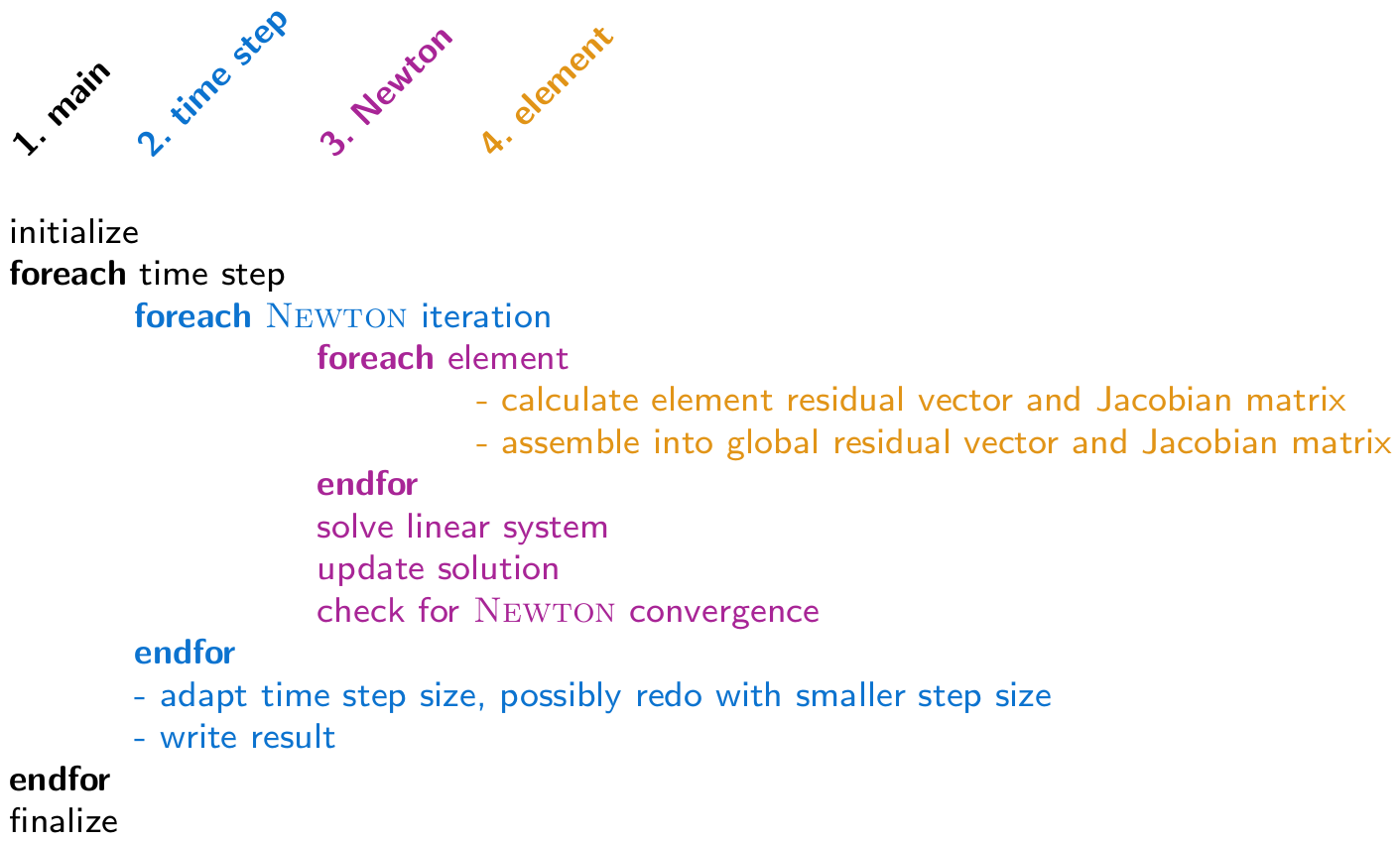Introduction to DuMux
Overview and Available Models
Table of Contents
Table of Contents
Structure and Development History
DuMux is a DUNE module
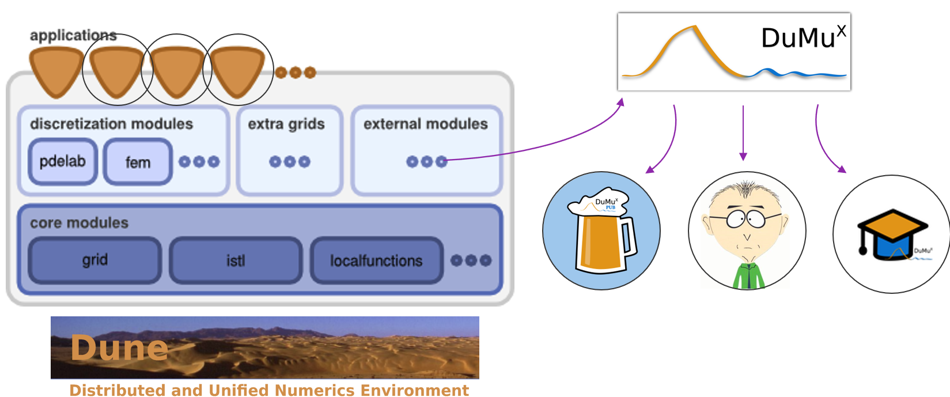
The DUNE Framework
- Developed by scientists at around 10 European research institutions.
- Separation of data structures and algorithms by abstract interfaces.
- Efficient implementation using generic programming techniques.
- Reuse of existing FE packages with a large body of functionality.
- Current stable release: 2.10 (October 2024).
DUNE Core Modules
- dune-common: basic classes
- dune-geometry: geometric entities
- dune-grid: abstract grid/mesh interface
- dune-istl: iterative solver template library
- dune-localfunctions: finite element shape functions
Overview

- DuMux: DUNE for Multi-{Phase, Component, Scale, Physics, \(\text{...}\)} flow and transport in porous media.
- Goal: sustainable, consistent, research-friendly framework for the implementation and application of FV discretization schemes, model concepts, and constitutive relations.
- Developed by more than 30 PhD students and post docs, mostly at LH2 (Uni Stuttgart).
Applications
Successfully applied to
- gas (CO2, H2, CH4, \(\text{...}\)) storage scenarios
- environmental remediation problems
- transport of substances in biological tissue
- subsurface-atmosphere coupling (Navier-Stokes / Darcy)
- flow and transport in fractured porous media
- root-soil interaction
- pore-network modelling
- developing new finite volume schemes
DuMux Modules
- dumux-lecture: example applications for lectures offered by LH2, Uni Stuttgart
- dumux-pub/—: code and data accompanying a publication (reproduce and archive results)
- dumux-appl/—: Various application modules (many not publicly available, e.g. ongoing research)
Development History
- 01/2007: Development starts.
- 07/2009: Release 1.0.
- 09/2010: Split into stable and development part.
- 12/2010: Anonymous read access to the SVN trunk of the stable part.
- 02/2011: Release 2.0, \(\text{...}\), 10/2017: Release 2.12.
- 09/2015: Transition from Subversion to Git.
- 12/2018: Release 3.0, \(\text{...}\), 04/2025: Release 3.10.
Funding
Efforts mainly funded through resources at the LH2: Department of Hydromechanics and Modelling of Hydrosystems at the University of Stuttgart and third-party funding acquired at the LH2

Funding
We acknowledge funding that supported the development of DuMux in past and present:
Downloads and Publications
- More than 1000 unique release downloads.
- More than 250 peer-reviewed publications and PhD theses using DuMux.
Evolution of C++ Files
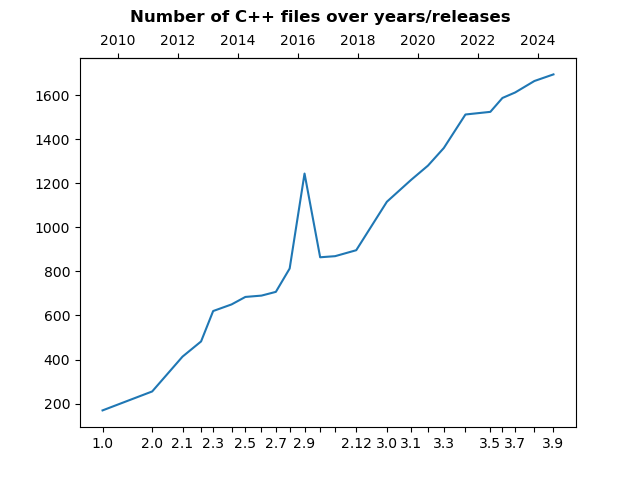
Evolution of Code Lines
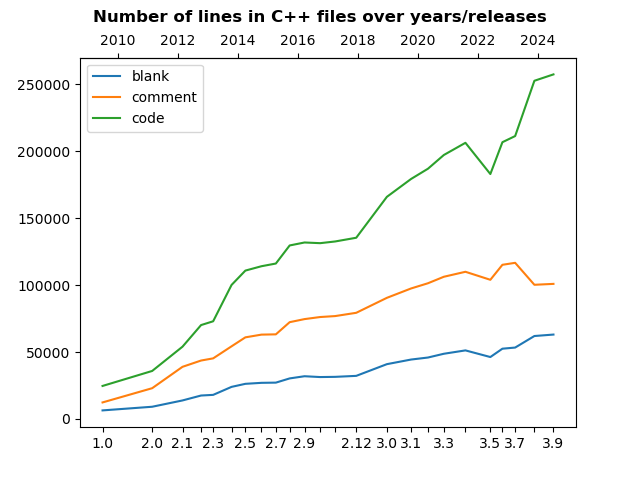
Folder structure
dumux
├── build-cmake
│ ├── examples
│ ├── test
│ ├── ...
├── doc
├── dumux
├── examples
├── test
└── ...- Further details can be found in the corresponding documentation
Mailing Lists and GitLab
- Mailing lists of DUNE (dune@dune-project.org) and DuMux (dumux@listserv.uni-stuttgart.de)
- GitLab Issue Tracker (https://git.iws.uni-stuttgart.de/dumux-repositories/dumux/issues)
- Get GitLab accounts (non-anonymous) for better
access
- DUNE GitLab (https://gitlab.dune-project.org/core)
- DuMux GitLab (https://git.iws.uni-stuttgart.de/dumux-repositories/dumux)
Documentation
- Code documentation
- DuMux Examples (https://git.iws.uni-stuttgart.de/dumux-repositories/dumux/-/tree/master/examples#examples)
- DuMux Website (https://dumux.org/)
Mathematical Models
Mathematical Models
Preimplemented models:
- Flow in porous media (Darcy): Single and multi-phase models for flow and transport in porous materials.
- Free flow (Navier-Stokes): Single-phase models based on the Navier-Stokes equations.
- Shallow water flow: Two-dimensional shallow water flow (depth-averaged).
- Geomechanics: Models taking into account solid deformation of porous materials.
- Pore network: Single and multi-phase models for flow and transport in pore networks.
Flow in Porous Media
 Credit: H.
Class, R. Helmig, P. Bastian. Numerical simulation of non-isothermal
multiphase multicomponent processes in porous media.: 1. An efficient
solution technique
Credit: H.
Class, R. Helmig, P. Bastian. Numerical simulation of non-isothermal
multiphase multicomponent processes in porous media.: 1. An efficient
solution technique
Darcy’s law
Describes the advective flux in porous media on the macro-scale
Single-phase flow \[ \mathbf{v} = - \frac{\mathbb{K}}{\mu} \left(\textbf{grad}\, p - \varrho \mathbf{g} \right) \]
Multi-phase flow (phase \(\alpha\)) \[ \mathbf{v}_\alpha = - \frac{k_{\text{r}\alpha}}{\mu_\alpha} \mathbb{K} \left(\textbf{grad}\, p_\alpha - \varrho_\alpha \mathbf{g} \right) \] where \(k_{\text{r}\alpha}(S_\alpha)\) is the relative permeability, a function of saturation \(S_\alpha\).
For non-creeping flow, Forchheimer’s law is available as an alternative.
1p – Single-Phase
Uses standard Darcy approach for the conservation of momentum by default
Mass continuity equation \[ \frac{\partial\left( \phi \varrho \right)}{\partial t} + \text{div} \left( \varrho \mathbf{v} \right) = q \]
Primary variable: \(p\)
Further details can be found in the corresponding documentation
1pnc – Single-Phase, Multi-Component
Uses standard Darcy approach for the conservation of momentum by default
Transport of component \(\kappa \in \{\text{H2O}, \text{Air}, ...\}\) \[ \frac{\partial\left( \phi \varrho X^\kappa \right)}{\partial t} + \text{div} \left( \varrho X^\kappa \mathbf{v} - \varrho \mathbb{D}^\kappa_\text{pm} \textbf{grad} X^\kappa \right) = q \]
Closure relation: \(\sum_\kappa X^\kappa = 1\)
Primary variables: \(p\) and \(X^\kappa\)
Further details can be found in the corresponding documentation
1pncmin – with Fluid-Solid Phase Change
Transport equation for each component \(\kappa \in \{\text{H2O}, \text{Air}, ...\}\) \[ \frac{\partial \left( \varrho_f X^\kappa \phi \right)}{\partial t} + \text{div} \left( \varrho_f X^\kappa \mathbf{v} - \varrho_f \mathbb{D}_\text{pm}^\kappa \textbf{grad}\, X^\kappa \right) = q_\kappa \]
Mass balance solid phases \[ \frac{\partial \left(\varrho_\lambda \phi_\lambda \right)}{\partial t} = q_\lambda \]
Primary variables: \(p\), \(X^k\) and \(\phi_\lambda\)
Further details can be found in the corresponding documentation
2p – Two-Phase Immiscible
Uses standard multi-phase Darcy approach for the conservation of momentum by default
Conservation of the phase mass of phase \(\alpha \in \{\text{w}, \text{n}\}\) \[ \frac{\partial \left(\phi \varrho_\alpha S_\alpha \right)}{\partial t} + \text{div} \left(\varrho_\alpha \mathbf{v}_\alpha \right) = q_\alpha \]
Constitutive relations: \(p_\text{c} := p_\text{n} - p_\text{w} = p_\text{c}(S_\text{w})\), \(k_{\text{r}\alpha}\) = \(k_{\text{r}\alpha}(S_\text{w})\)
Physical constraint (void space filled with fluid phases): \(S_\text{w} + S_\text{n} = 1\)
Primary variables: \(p_\text{w}\), \(S_\text{n}\) or \(p_\text{n}\), \(S_\text{w}\)
Further details can be found in the corresponding documentation
2pnc – Two-Phase Compositional
Transport equation for each component \(\kappa \in \{\text{H2O}, \text{Air}, ...\}\) in phase \(\alpha \in \{\text{w}, \text{n}\}\) \[ \begin{aligned} \frac{\partial \left( \sum_\alpha \varrho_\alpha X_\alpha^\kappa \phi S_\alpha \right)}{\partial t} &+ \sum_\alpha \text{div}\left( \varrho_\alpha X_\alpha^\kappa \mathbf{v}_\alpha - \varrho_\alpha \mathbb{D}_{\alpha, \text{pm}}^\kappa \textbf{grad}\, X^\kappa_\alpha \right) = \sum_\alpha q_\alpha^\kappa \end{aligned} \]
Constitutive relation: \(p_\text{c} := p_\text{n} - p_\text{w} = p_\text{c}(S_\text{w})\), \(k_{\text{r}\alpha}\) = \(k_{\text{r}\alpha}(S_\text{w})\)
Physical constraints: \(S_\text{w} + S_\text{n} = 1\) and \(\sum_\kappa X_\alpha^\kappa = 1\)
Primary variables: depending on the phase state
Further details can be found in the corresponding documentation
2pncmin
Transport equation for each component \(\kappa \in \{\text{H2O}, \text{Air}, ...\}\) \[ \begin{aligned} \frac{\partial \left( \sum_\alpha \varrho_\alpha X_\alpha^\kappa \phi S_\alpha \right)}{\partial t} &+ \sum_\alpha \text{div}\left( \varrho_\alpha X_\alpha^\kappa \mathbf{v}_\alpha - \varrho_\alpha \mathbb{D}_{\alpha, \text{pm}}^\kappa \textbf{grad}\, X^\kappa_\alpha \right)= \sum_\alpha q_\alpha^\kappa \end{aligned} \]
Mass balance solid phases \[ \frac{\partial \left(\varrho_\lambda \phi_\lambda \right)}{\partial t} = q_\lambda \quad \forall \lambda \in \Lambda \] for a set of solid phases \(\Lambda\) each with volume fraction \(\varrho_\lambda\)
Source term models dissolution/precipiation/phase transition fluid ↔︎ solid
Further details can be found in the corresponding documentation
3p – Three-Phase Immiscible
Uses standard multi-phase Darcy approach for the conservation of momentum by default
Conservation of the phase mass of phase \(\alpha \in \{\text{w}, \text{g}, \text{n}\}\) \[ \frac{\partial \left( \phi \varrho_\alpha S_\alpha \right)}{\partial t} - \text{div} \left( \varrho_\alpha \mathbf{v}_\alpha \right) = q_\alpha \]
Physical constraint: \(S_\text{w} + S_\text{n} + S_\text{g} = 1\)
Primary variables: \(p_\text{g}\), \(S_\text{w}\), \(S_\text{n}\)
Further details can be found in the corresponding documentation
3p3c – Three-Phase Compositional
Transport equation for each component \(\kappa \in \{\text{H2O}, \text{Air}, \text{NAPL}\}\) in phase \(\alpha \in \{\text{w}, \text{g}, \text{n}\}\) \[ \begin{aligned} \frac{\partial \left( \phi \sum_\alpha \varrho_{\alpha,\text{mol}} x_\alpha^\kappa S_\alpha \right)}{\partial t}&+ \sum_\alpha \text{div} \left( \varrho_{\alpha,\text{mol}} x_\alpha^\kappa \mathbf{v}_\alpha - \frac{\varrho_{\alpha, \text{mol}}}{M_\kappa} \mathbb{D}_{\alpha, \text{pm}}^\kappa \textbf{grad} X^\kappa_{\alpha} \right) = q^\kappa \end{aligned} \]
Physical constraints: \(\sum_\alpha S_\alpha = 1\) and \(\sum_\kappa x^\kappa_\alpha = 1\)
Primary variables: depend on the locally present fluid phases
Further details can be found in the corresponding documentation
Other Porous-Medium Flow Models
For other porous-medium flow models, we refer to the Doxygen documentation:
Non-Isothermal (Equilibrium)
Local thermal equilibrium assumption
One energy conservation equation for the porous solid matrix and the fluids
\[ \begin{aligned}\frac{\partial \left( \phi \sum_\alpha \varrho_\alpha u_\alpha S_\alpha \right)}{\partial t} &+ \frac{\partial \left(\left(1 - \phi \right)\varrho_\text{s} c_\text{s} T \right)}{\partial t} + \sum_\alpha \text{div} \left( \varrho_\alpha h_\alpha \mathbf{v}_\alpha \right) - \text{div} \left(\lambda_\text{pm} \textbf{grad}\, T \right) = q^h \end{aligned} \]
Specific internal energy \(u_\alpha = h_\alpha - p_\alpha / \varrho_\alpha\)
Can be added to other models, additional primary variable temperature \(T\)
Further details can be found in the corresponding documentation
Free Flow (Navier-Stokes)
- Stokes equation
- Navier-Stokes equations
- Energy and component transport
Reynolds-Averaged Navier-Stokes (RANS)
Momentum balance equation for a single-phase, isothermal RANS model
\[ \frac{\partial \left(\varrho \textbf{v} \right)}{\partial t} + \nabla \cdot \left(\varrho \textbf{v} \textbf{v}^{\text{T}} \right) = \nabla \cdot \left(\mu_\textrm{eff} \left(\nabla \textbf{v} + \nabla \textbf{v}^{\text{T}} \right) \right) - \nabla p + \varrho \textbf{g} - \textbf{f} \]
The effective viscosity is composed of the fluid and the eddy viscosity
\[ \mu_\textrm{eff} = \mu + \mu_\textrm{t} \]
Various turbulence models are implemented
More details can be found in the Doxygen documentation
Other Models
For other models, we refer to the Doxygen documentation:
Your Model Equations?
Spatial Discretization
Cell-centered Finite Volume Methods
- Elements of the grid are used as control volumes
- Discrete values represent control volume average
- Two-point flux approximation (TPFA)
- Simple and robust but not always consistent
- Multi-point flux approximation (MPFA)
- A consistent discrete gradient is constructed
Two-Point Flux Approximation (TPFA)
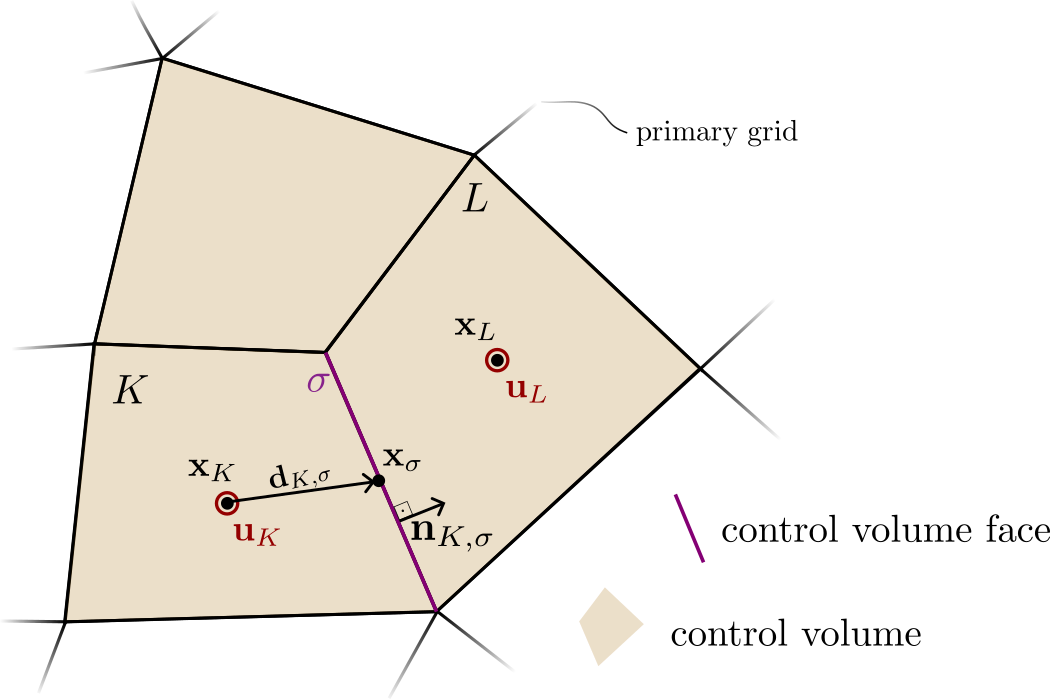
Multi-Point Flux Approximation (MPFA)
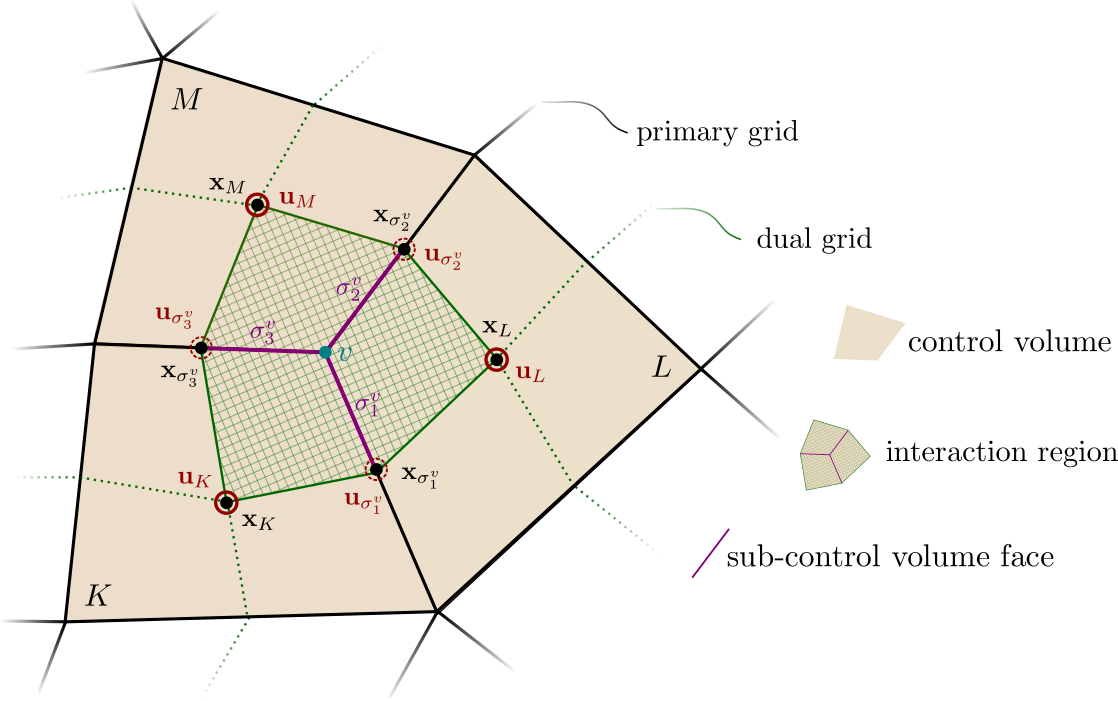
Control-Volume Finite Element Methods
- Model domain is discretized using a FE mesh
- Secondary FV mesh is constructed → control volume/box
- Control volumes (CV) split into sub control volumes (SCVs)
- Faces of CV split into sub control volume faces (SCVFs)
- Unites advantages of finite-volume (simplicity) and finite-element
methods (flexibility)
- Unstructured grids (from FE method)
- Mass conservation (from FV method)
Box Method
Vertex-centered finite volumes / control volume finite element method with piecewise linear polynomial functions (\(\mathrm{P}_1/\mathrm{Q}_1\))

Diamond Scheme
Face-centered finite-volume scheme based on non-conforming finite-element spaces
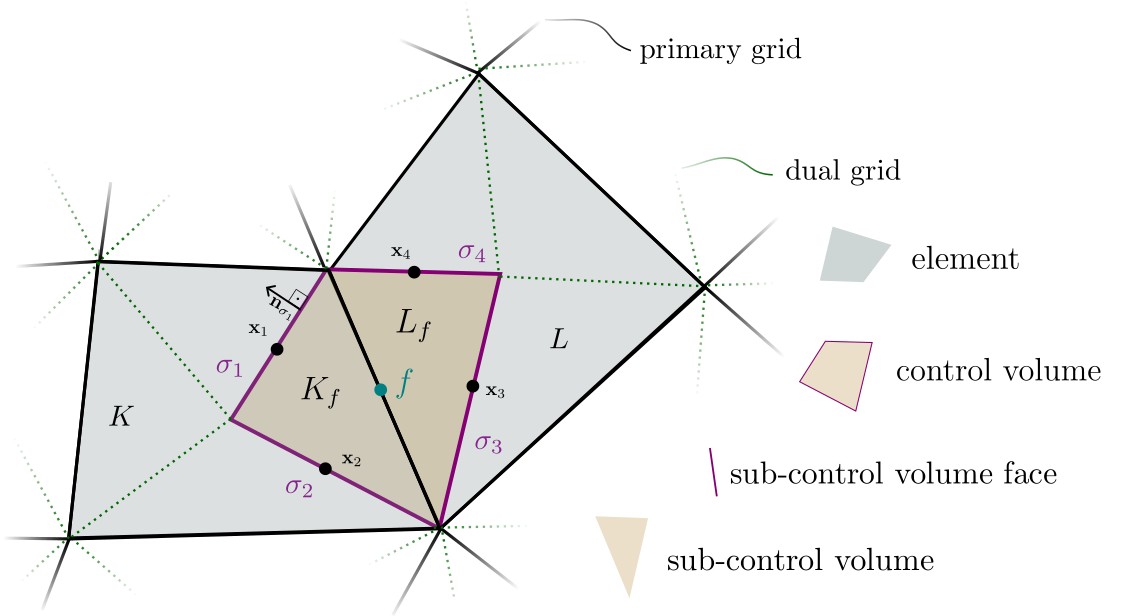
PQ1 Bubble Scheme
Control-volume finite element scheme based on \(\mathrm{P}_1/\mathrm{Q}_1\) basis functions with enrichment by a bubble function
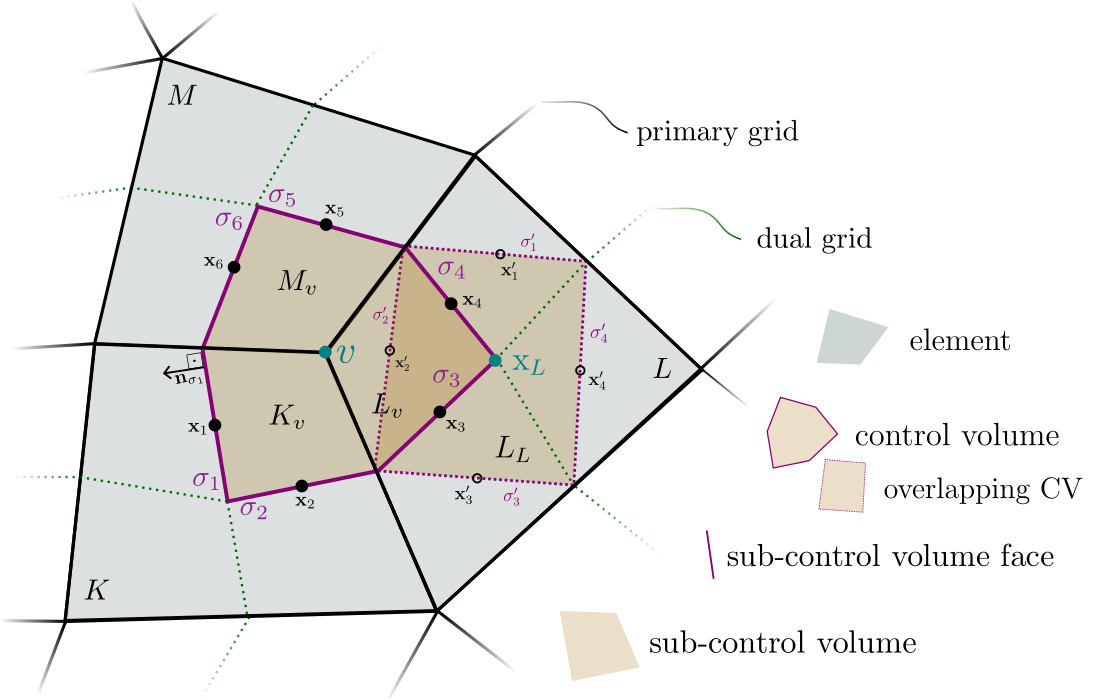
Finite Volume Method on Staggered Control Volumes
- Uses a finite volume method with different staggered control volumes for different equations
- Fluxes are evaluated with a two-point flux approximation
- Robust and mass conservative
- Restricted to structured grids (tensor-product structure)
Staggered Grid Discretization
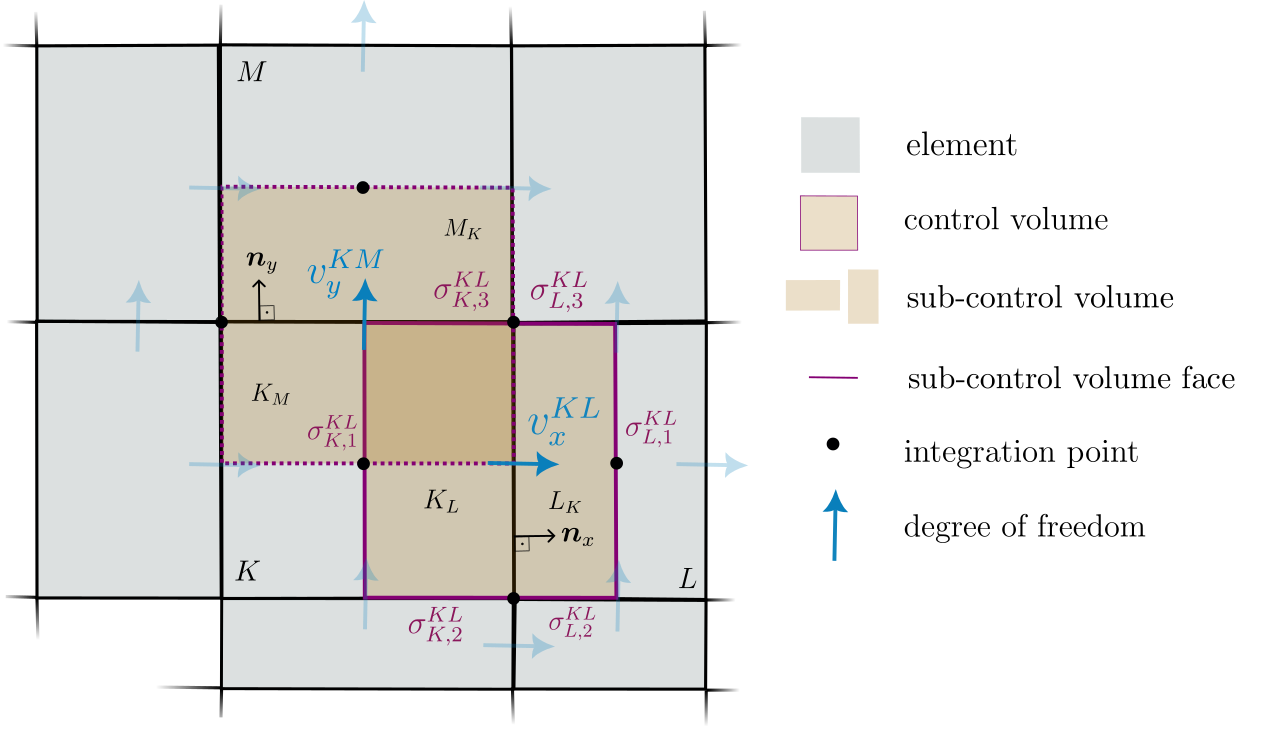
Model Components
Model Components
- Typically, the following components have to be specified
- Model: Equations and constitutive models
- Assembler: Key properties (Discretization, Variables, LocalResidual)
- Solver: Type of solution strategy (e.g. Newton)
- LinearSolver: Method for solving linear equation systems (e.g. direct / Krylov subspace methods)
- Problem: Initial and boundary conditions, source terms
- TimeLoop: For time-dependent problems
- VtkOutputModule / IOFields: For VTK output of the simulation
Simulation Flow
Simulation Flow
